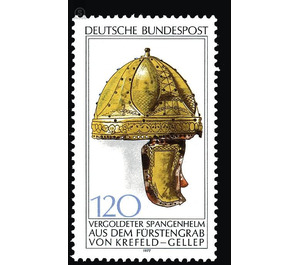Archaeological Heritage (2) - Germany / Federal Republic of Germany 1977 - 120 Pfennig
Theme: Art & Culture
| Country | Germany / Federal Republic of Germany |
| Issue Date | 1977 |
| Face Value | 120.00 |
| Color | brown white |
| Perforation | K 14 |
| Printing Type | Multicolor offset printing |
| Stamp Type | Postage stamp |
| Item Type | Stamp |
| Chronological Issue Number | 833 |
| Chronological Chapter | GER-BRD |
| SID | 875053 |
| In 30 Wishlists | |
In the excavation of a cemetery of several thousand graves from Roman and Frankish times in Krefeld-Gellep came in the fall of 1962 on an unusually richly decorated grave of a Franconian prince. The most magnificent find of the tomb - dating from around 525 AD - is undoubtedly the gilded spangled helmet. It consists of several arched sheet iron plates, which are clad on the outside of gilded bronze sheet. Above the seams, bronze plate plates are riveted in the shape of a clasp, which are held together at the top by the helmet knob. The lower end forms a wide Stirnreif. Between two side cheek flaps an iron chain mesh was originally hung on the back as neck protection, which is not preserved except for a few fragments. Inside, the helmet was lined with leather, which had been turned over at the lower edge and sewn there.


